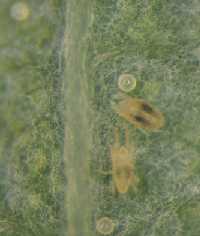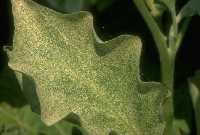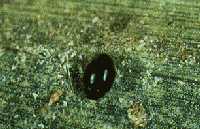by W.S. Cranshaw and D.C. Sclar* (7/14)
Quick Facts…
- Spider mites are common plant pests. Symptoms of injury include flecking, discoloration (bronzing) and scorching of leaves. Injury can lead to leaf loss and even plant death.
- Natural enemies include small lady beetles, predatory mites, minute pirate bugs, big-eyed bugs and predatory thrips.
- One reason that spider mites become a problem is insecticides that kill their natural predators.
- Irrigation and moisture management can be important cultural controls for spider mites.

Figure 1: Honeylocust spider mites, with eggs. |
Spider mites are common pest problems on many plants around yards and gardens in Colorado. Injury is caused as they feed, bruising the cells with their small, whiplike mouthparts and ingesting the sap. Damaged areas typically appear marked with many small, light flecks, giving the plant a somewhat speckled appearance.
Following severe infestations, leaves become discolored, producing an unthrifty gray or bronze look to the plant. Leaves and needles may ultimately become scorched and drop prematurely. Spider mites frequently kill plants or cause serious stress to them.
Spider mites (Family: Tetranychidae) are classed as a type of arachnid, relatives of insects that also includes spiders, ticks, daddy-longlegs and scorpions. Spider mites are small and often difficult to see with the unaided eye. Their colors range from red and brown to yellow and green, depending on the species of spider mite and seasonal changes in their appearance.
Many spider mites produce webbing, particularly when they occur in high populations. This webbing gives the mites and their eggs some protection from natural enemies and environmental fluctuations. Webbing produced by spiders, as well as fluff produced by cottonwoods, often is confused with the webbing of spider mites.
The most important spider mite is the twospotted spider mite (Tetranychus urticae). This mite attacks a wide range of garden plants, including many vegetables (e.g., beans, eggplant), fruits (e.g., raspberries, currants, pear) and flowers. The twospotted spider mite is also the most important species on house plants. It is a prolific producer of webbing.
Evergreens tend to host other mites, notably the spruce spider mite (Oligonychus ununguis) on spruce and juniper, Oligonychus subnudus on pines, and Platytetranychus libocedri on arborvitae and juniper. Honeylocust, particularly those in drier sites, are almost invariably infested with the honeylocust spider mite (Platytetranychus multidigituli). Other mites may affect shade trees such as elm, mountain ash and oak.
Another complex of mites is associated with turfgrass, including the clover mite and Banks grass mite. These are discussed separately in fact sheet 5.505, Clover and Other Mites of Turfgrass. Clover mites also are the common mite that enters homes in fall and spring, sometimes creating significant nuisance problems in the process.

Figure 2: Twospotted spider mites, with eggs. |
Life History and Habits
Spider mites develop from eggs, which usually are laid near the veins of leaves during the growing season. Most spider mite eggs are round and extremely large in proportion to the size of the mother. After egg hatch, the old egg shells remain and can be useful in diagnosing spider mite problems.
There is some variation in the habits of the different mites that attack garden plants, trees and shrubs. Outdoors, the twospotted spider mite and honeylocust spider mite survive winter as adults hidden in protected areas such as bark cracks, bud scales or under debris around the garden. Other mites survive the cool season in the egg stage. As winter approaches, most mites change color, often turning more red or orange. This habit may be why they are sometimes called “red spiders.”
Most spider mite activity peaks during the warmer months. They can develop rapidly during this time, becoming full-grown in as little as a week after eggs hatch. After mating, mature females may produce a dozen eggs daily for a couple of weeks. The fast development rate and high egg production can lead to extremely rapid increases in mite populations.
Other species of spider mites are most active during the cooler periods of the growing season, in spring and fall. This includes the spruce spider mite and most of the mites that can damage turfgrass. These cool-season spider mites may cease development and produce dormant eggs to survive hot summer weather.
Dry conditions greatly favor all spider mites, an important reason why they are so important in the more arid areas of the country. They feed more under dry conditions, as the lower humidity allows them to evaporate excess water they excrete. At the same time, most of their natural enemies require more humid conditions and are stressed by arid conditions. Furthermore, plants stressed by drought can produce changes in their chemistry that make them more nutritious to spider mites.
Control
Biological Controls
Various insects and predatory mites feed on spider mites and provide a high level of natural control. One group of small, dark-colored lady beetles known as the “spider mite destroyers” (Stethorus species) are specialized predators of spider mites. Minute pirate bugs, big-eyed bugs (Geocoris species) and predatory thrips can be important natural enemies.

Figure 3: Twospotted spider mite injury to eggplant. |

Figure 4: “Spider mite destroyer” lady beetle. |

Figure 5: Minute pirate bug. |
A great many mites in the family Phytoseiidae are predators of spider mites. In addition to those that occur naturally, some of these are produced in commercial insectaries for release as biological controls. Among those most commonly sold via mail order are Galendromus occidentalis, Phytoseiulus persimilis, Mesoseiulus longipes and Neoseiulus californicus. Although these have been successful in control of spider mites on interior plants, effective use outdoors has not been demonstrated in Colorado. Predatory mites often have fairly high requirements for humidity, which can be limiting. Most suppliers provide information regarding use of the predator mites that they carry.
One reason that spider mites become problems in yards and gardens is the use of insecticides that destroy their natural enemies. For example, carbaryl (Sevin) devastates most spider mite natural enemies and can greatly contribute to spider mite outbreaks. Malathion can aggravate some spider mite problems, despite being advertised frequently as effective for mite control. Soil applications of the systemic insecticide imidacloprid (Merit, Marathon) have also contributed to some spider mite outbreaks.
Water Management
Adequate watering of plants during dry conditions can limit the importance of drought stress on spider mite outbreaks. Periodic hosing of plants with a forceful jet of water can physically remove and kill many mites, as well as remove the dust that collects on foliage and interferes with mite predators. Disruption of the webbing also may delay egg laying until new webbing is produced. Sometimes, small changes where mite-susceptible plants are located or how they are watered can greatly influence their susceptibility to spider mite damage.
Chemical Controls
Chemical control of spider mites generally involves pesticides that are specifically developed for spider mite control (miticides or acaricides). Few insecticides are effective for spider mites and many even aggravate problems. Furthermore, strains of spider mites resistant to pesticides frequently develop, making control difficult. Because most miticides do not affect eggs, a repeat application at an approximately 10- to 14-day interval is usually needed for control. Table 1 includes a summary of pesticides that may be useful for managing spider mites.
Control of Spider Mites on House Plants
Control on house plants can be particularly frustrating. There generally are no biological controls and few effective chemical controls (primarily soaps and horticultural oils). When attempting control, treat all susceptible house plants at the same time. Trim, bag and remove heavily infested leaves and discard severely infested plants. Periodically hose small plants in the sink or shower. Wipe leaves of larger plants with a soft, damp cloth. Reapply these treatments at one- to two-week intervals as long as populations persist.
| Table 1: Pesticides useful to control spider mites in yards and gardens. | ||
| Active Ingredient | Trade Name(s) | Comments |
| acephate | Orthene, certain Isotox formulations | Insecticide with some effectiveness against spider mites. Systemic. |
| abamectin | Avid | For commercial use only on ornamental plants. Primarily effective against twospotted spider mite; less effective against mites on conifers. Limited systemic movement. |
| bifenthrin | Talstar, others | Insecticide with good miticide activity. |
| hexythiazox | Hexygon | For commercial use only on ornamental plants. Selective miticide that affects developing stages and eggs only. One application per season label restriction. |
| horticultural oils | Sunspray, others | Used at the “summer oil” rate (2 percent), oils are perhaps the most effective miticide available for home use. |
| insecticidal soap | several | Marginally effective against twospotted spider mite and where webbing prevents penetration. Broadly labeled. |
| spiromesifan | Forbid | For commercial use only on ornamental plants. Selective against mites and conserves natural enemies. |
| sulfur | various | Generally sold in dust formulation for control of various fungal diseases and some mites on some ornamental and vegetable crops. |
*W.S. Cranshaw, Colorado State University Extension entomologist and professor, and D.C. Sclar, former research assistant; bioagricultural sciences and pest management. 12/98. Revised 7/14.
Colorado State University, U.S. Department of Agriculture, and Colorado counties cooperating. Extension programs are available to all without discrimination. No endorsement of products mentioned is intended nor is criticism implied of products not mentioned.
Go to top of this page.





